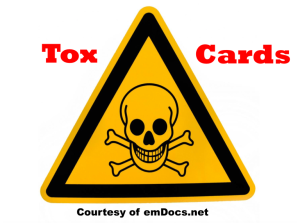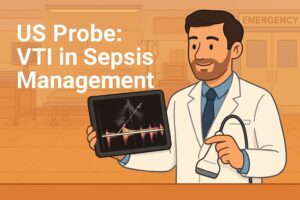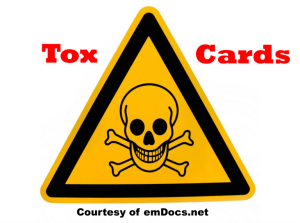Author: Nitin Ubhayakar, MD (White Memorial, Los Angeles, CA) // Reviewed by: Cynthia Santos, MD (@CynthiaSantosMD, Assistant Professor, Emergency Medicine, Medical Toxicology, Rutgers NJMS); Alex Koyfman, MD (@EMHighAK); Brit Long, MD (@long_brit)

Case:
A 13-month-old male with no known past medical history is transported to the emergency department by EMS after a suspected ingestion. Per family, the child was found holding an open bottle of adhesive remover. As there was concern that he may have drank some of the contents, EMS was called. On their arrival, the child was drowsy. Blood sugar was within normal limits and IV access was established. En route to the hospital, the child became sleepier and blow-by oxygen was provided as there was concern for possible hypoxia. On arrival to the ED, the child is somnolent. Family at bedside report a history of coughing prior to arrival. Vitals are T: 98F HR: 128 B/P: 101/68 RR: 28 SpO2: 100% Exam reveals a child who appears to be sleeping. He is able to intermittently open his eyes, cry and move all extremities when examined but falls back asleep. There is no evidence of obvious trauma. EMS hands you the bottle of the adhesive remover, and you read the following text: “Danger: Harmful if Swallowed. Contains Hydrocarbons.”
Background:
- Hydrocarbons are a ubiquitous group of chemicals found in a number of household products ranging from cosmetics to cleaning and automotive products.
- There are 4 structural classes of hydrocarbons: halogenated hydrocarbons, aliphatic hydrocarbons, aromatic hydrocarbons and terpenes (1).
Epidemiology:
- Hydrocarbon ingestion accounts for 1-2% of non-pharmaceutical exposures reported to poison control, but represents nearly 10% of exposure-related deaths in children under the age of six (2).
Pearls:
- Hydrocarbon toxicity occurs either from accidental or intentional ingestion, inhalation or topical exposure.
- Toxicity varies greatly and is based on the route of exposure, dose and concentration of the hydrocarbon and its physical and chemical characteristics including viscosity, volatility and surface tension (3).
- Although all hydrocarbons pose a direct risk if aspirated, systemic toxicity from exposure is most common with aromatic and halogenated hydrocarbons due to their volatility and absorption from the gastrointestinal tract (1,4)
- Pulmonary complications are the most commonly reported adverse effect and usually result from aspiration of an ingested hydrocarbon. Hydrocarbon aspiration leads to direct lung injury, including necrotizing chemical pneumonitis and hemorrhagic pulmonary edema, which can manifest as a cough or shortness of breath and rapidly progress to hypoxia and respiratory failure (1,3).
- CNS complications can result from hydrocarbon ingestion or inhalation and include lethargy, decreased responsiveness, coma and seizures. Hydrocarbons are hypothesized to cause CNS depression by their effects on NMDA, dopamine and GABA receptors (3).
- Cardiovascular complications can result from ingestion or inhalation of hydrocarbons. Specifically, hydrocarbons are believed to produce an increase in myocardial sensitization to endogenous and exogenous catecholamines leading to increased risk of lethal tachydysrhythmias like ventricular fibrillation (3,5).
- “Sudden Sniffing Death Syndrome” is a documented phenomenon that has been reported with all classes of hydrocarbons but most commonly seen in those individuals inhaling halogenated hydrocarbons (6). The syndrome refers to sudden cardiac arrest that occurs when someone who has ingested or inhaled hydrocarbons is suddenly startled leading to a catecholamine surge/burst with resultant malignant arrhythmia (1,3,6).
- While most cases are unwitnessed, those case reports of patients making it to the hospital and surviving have indicated that beta-blockers like esmolol may provide benefit by counteracting the effects of myocardial sensitization by catecholamines (7). Antiarrhythmics like amiodarone may also be of benefit (8).
- Use of intravenous catecholamines (ie epinephrine, norepinephrine) in cases of hydrocarbon exposure is thought to possibly worsen or precipitate a malignant arrhythmias (8). Additionally, arrhythmias due hydrocarbon exposure may be refractory and/or resistant to standard ACLS interventions like defibrillation (8).
- Topical exposure to certain hydrocarbons can cause cell membrane injury leading to burns and skin necrosis from prolonged contact (1).
- Hepatic injury and renal tubular necrosis have also been reported with halogenated hydrocarbon exposure (1).
Treatment Approach:
- Management of hydrocarbon exposure focuses largely on supportive care and appreciation of the expected complications of a known ingestion, inhalation or dermal exposure.
- Consultation with Poison Control is recommended for assistance with identifying the complications associated with a specific hydrocarbon exposure.
- The patient should be closely observed ideally in a quiet environment with minimal auditory, tactile or visual stimuli so as not to provoke a catecholamine surge.
- Activated charcoal is CONTRAINDICATED in cases of hydrocarbon ingestion as it increases the risk of aspiration and does not bind well to hydrocarbons (1).
- Select patients who present within 60 minutes of a large volume and potentially lethal ingestion may benefit from nasogastric lavage. Case reports have used ice-cold saline for hourly gastric lavage with success (9).
- Pulmonary management from known or suspected aspiration centers around supportive care including supplemental oxygen, close monitoring of respiratory status and low threshold for intubation (1). Chest x-ray should be obtained at 4-6 hour after hydrocarbon ingestion or sooner if patient is symptomatic (1).
- The patient’s mental status should be closely monitored with a low threshold for intubation. Additionally, patients with seizures should receive intravenous benzodiazepines (1).
- Although malignant arrhythmias should be managed utilizing Advanced Cardiac Life Support and Pediatric Advanced Life Support, consideration should be given toward avoiding epinephrine and other catecholamines and considering beta-blockers and antiarrhythmics in patients with refractory ventricular fibrillation (1).
- In cases of topical exposure, contaminated clothing should be removed, and affected hair, skin or eyes should be cleansed with copious water irrigation (1).
Disposition:
All patients presenting with hydrocarbon ingestion should be observed for at least 6 hours. Patients should be admitted if they are symptomatic on presentation, develops symptoms during the observation period or endorse suicidal ideations. Asymptomatic patients with mild abnormalities on chest x-ray can be considered for discharge assuming they have good follow-up (1).
Case Conclusion:
You quickly determine that the child is “Purple” on the Broselow-Luten pediatric tape and make a mental note of specific emergency medication dosing recommendations. The child is placed on continuous pulse oximetry and telemetry. Repeat blood sugar in the emergency department is also within normal limits. Since the patient is somnolent but arousable on initial exam, you hold off on intubation but keep airway equipment at bedside. CXR ordered to evaluate respiratory symptoms does not reveal any acute disease. He is subsequently admitted to the pediatric intensive care unit for frequent neuro, respiratory and hemodynamic monitoring. The patient’s mental status returns to normal, and he is discharged the next day.
References:
- Lewander, WJ. Hydrocarbon Poisoning. Post TW, ed. UpToDate. Waltham, MA: UpToDate Inc. 2019.
- Bronstein AC, Spyker DA, Cantilena LR Jr, Green JL, Rumack BH, Giffin SL. 2009 Annual Report of the American Association of Poison Control Centers’ National Poison Data System (NPDS): 27th Annual Report. Clin Toxicol (Phila). 2010 Dec;48(10):979-1178.
- Tormoehlen LM, Tekulve KJ, Nañagas KA. Hydrocarbon toxicity: A review. Clin Toxicol (Phila). 2014 Jun;52(5):479-89.
- Lewander, WJ, Aleguas, A. Petroleum distillates and plant hydrocarbons. In: Haddad and Winchester’s Clinical Management of Poisoning and Drug Overdose, 4th edition. Saunders Elsevier, Philadelphia 2007, 1343.
- Nelson LS. Toxicologic myocardial sensitization. J Toxicol Clin Toxicol. 2002;40(7):867-79. Review.
- Bass M. Sudden sniffing death. JAMA. 1970 Jun 22;212(12):2075-9.
- Mortiz F, de La Chapelle A, Bauer F, Leroy JP, Goullé JP, Bonmarchand G. Esmolol in the treatment of severe arrhythmia after acute trichloroethylene poisoning. Intensive Care Med. 2000 Feb;26(2):256.
- Edwards KE, Wenstone R. Successful resuscitation from recurrent ventricular fibrillation secondary to butane inhalation. Br J Anaesth. 2000 Jun;84(6):803-5.
- Guo CJ, S. Kaufman B. Chapter 65, Inhalational Anesthetics. In: Nelson LS, Howland M, Lewin NA, Smith SW, Goldfrank LR, Hoffman RS. eds. Goldfrank’s Toxicologic Emergencies, 11e New York, NY: McGraw-Hill. 2019.










1 thought on “TOXCard: Hydrocarbon Toxicity”
Pingback: Conference Recap 8/2/23 – Boston City EM